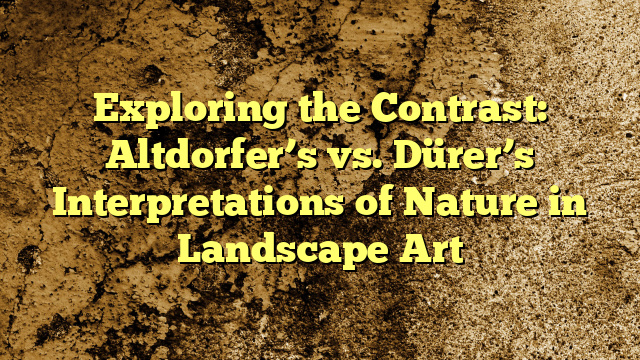Exploring the Contrast: Altdorfer’s vs. Dürer’s Interpretations of Nature in Landscape Art
Exploring the Contrast: Altdorfer’s vs. Dürer’s Interpretations of Nature in Landscape Art
The Renaissance period was a time of immense innovation and exploration in art, with artists seeking to capture the beauty, complexity, and majesty of the natural world in their works. Among these artists, Albrecht Altdorfer and Albrecht Dürer stand out for their distinctive interpretations of nature in landscape art. This article delves into the contrasts between Altdorfer’s and Dürer’s approaches to depicting nature, exploring their techniques, themes, and the impact of their work on the landscape genre.
Altdorfer’s Vision of Nature
Albrecht Altdorfer (c. 1480–1538) was a German painter, printmaker, and architect of the Renaissance period, known for his expressive and imaginative landscapes. Unlike many of his contemporaries, Altdorfer focused on the landscape itself as the primary subject of his art, rather than as a backdrop to historical or religious scenes.
Techniques and Style
- Use of Color: Altdorfer is renowned for his vibrant use of color, which brings his landscapes to life. He often used vivid greens and blues to depict the natural world, creating a sense of depth and richness.
- Attention to Detail: His works are characterized by an extraordinary attention to detail, with every leaf, branch, and rock meticulously rendered to create a complex and immersive natural scene.
- Emotional Impact: Altdorfer’s landscapes are not just detailed; they are imbued with emotion, often evoking a sense of awe or mysticism. His use of light and shadow, combined with his color palette, creates dramatic and moody atmospheres.
Notable Works
One of Altdorfer’s most famous works is The Battle of Alexander at Issus (1529), which, while primarily a historical painting, features a vast and detailed landscape that showcases his skill in depicting nature.
Dürer’s Interpretation of Nature
Albrecht Dürer (1471–1528), a contemporary of Altdorfer, was also a German artist of the Renaissance, but his approach to landscape art was markedly different. Dürer was a master engraver, painter, and theorist, whose works in landscape art were groundbreaking in their realism and technique.
Techniques and Style
- Realism: Dürer’s landscapes are celebrated for their incredible realism. He was one of the first artists to depict nature in a truly lifelike manner, studying the world around him in great detail to accurately represent it in his art.
- Scientific Approach: Dürer’s interest in science and mathematics influenced his art. He used principles of perspective and proportion to create depth and realism in his landscapes.
- Human Presence: Unlike Altdorfer, Dürer often included human figures in his landscapes, using them to add scale and to explore the relationship between humanity and the natural world.
Notable Works
Dürer’s Watercolor Landscapes are among his most celebrated contributions to landscape art. These works, including View of Arco, are praised for their detail, realism, and the way they capture the beauty of the natural world.
Comparative Analysis
| Aspect | Altdorfer | Dürer |
|---|---|---|
| Focus | Landscape as the main subject | Landscape with human elements |
| Technique | Vivid color, detailed, emotional | Realistic, scientific, proportional |
| Impact | Evokes awe and mysticism | Highlights realism and human-nature relationship |
Conclusion
Altdorfer and Dürer, two giants of the Renaissance, offered contrasting yet equally profound interpretations of nature in their landscape art. Altdorfer’s imaginative and emotive landscapes invite viewers into a vivid, detailed world, while Dürer’s realistic and scientifically-informed works emphasize the beauty and accuracy of the natural world. Together, their contributions not only advanced the genre of landscape art but also offered unique insights into the human experience of nature.
Exploring the contrasts between Altdorfer’s and Dürer’s interpretations of nature reveals the breadth of creativity and perspective that characterized Renaissance art. Their legacy continues to inspire artists and art lovers alike, demonstrating the enduring power and appeal of landscape art.

